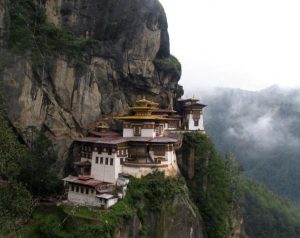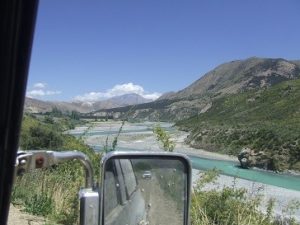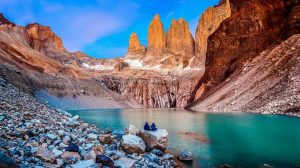Mongolia 8 – 26 August 2021/22
Day 1 Ulaanbaatar
The assembly point for the start of the trip is Ulaanbaatar, the capital of Mongolia, which has a population of around 1.5 million, the total population of Mongolia being just on 3 Million and we will be staying in the centre of the city in the Bayangol District. There will be a supermarket close at hand so you will need to stock up on some of your favourites for lunches to supplement the basic lunch starter pack which we have provided to get the trip kicked off.
This is a chance to meet the team, relax and discuss highlights of the trip ahead, evening meal and accommodation for this night are part of your package, as are transfers from the Airport to the Hotel.
We’ll head for dinner at around 5.00 pm for the trip briefing which will include details of the itinerary in the next few days, convoy procedures and a run down on local driving rules and conditions to expect along our route. We’ll also run through itinerary details such as accommodation at the various locations along the way, types of terrain you can expect to encounter on the journey, vehicle care, particular scenery and cultural highlights that we’ll experience on our fascinating adventure through this beautiful country.
Traffic conditions can be challenging getting out of Ulaanbaatar and you will be driving on the right hand side of the road, so we will make a very early start at around 5.30 am but this will make our start to the trip infinitely easier and well worth the effort of getting up at the crack of dawn.
Day 2 Ulaanbaatar to Baga Gazaryn Chuluu ( 260 Km )
Our Route today will follow the main Highway no 272 due South from Ulaanbaatar for approximately 200km, then turns due West for a 60km off road run to our Ger Camp at Baga Gazaryn Chuluu.
This is a very pretty location of pristine green valleys nestled amongst unusual rock outcrops located in Delgertsogt sum, Dundgovi province and surrounded by plain. The highest outcrop is a 15 km long and 10 km wide granite stone-mountain elevated at 1768m above sea level. There are also over 20 kinds of medical herbs like burnet to be found here, and many kinds of wild animals such as marmot, ibex and mountain sheep, so after getting acquainted with our first Ger Tent we will head out and explore this fascinating landscape.
Dinner and breakfast will be served at the central restaurant building at the entrance to the camp and there is a cosy outdoor area beside this building where pre dinner drinks and reflections on the first days experiences can be enjoyed.

Day 3 Baga Gazaryn Chuluu to Ongii Khiid ( 260 Km )
Heading approx. 260 km South West todays track will take us across some interesting country to a magic Ger Camp located on the banks of the Ongi Gol River at the edge of the Gobi desert.
Here we will get a chance to explore the site of the Ongiyn ruins, formerly one of the largest monasteries in Mongolia, originally founded in 1660 consisting of the South complex made up of 11 temples and the North complex made up of 17 Temples. The grounds also housed four Buddhist Universities but in 1939 the then communist party president Khorloogiin Choibalsan gave the order to destroy the monastery, over 200 monks were killed and the surviving monks were either imprisoned or forced to join the communist army. In the 1990’s it was decided to rebuild the monastery and at present more than 10 monks now reside here and tend to the reconstruction process.


Our second night in a very comfortable Ger camp and it’s hard to grasp that such a beautiful setting can be in one of the most isolated regions of the world. Dinner and breakfast as usual in the main dining area at the camp centre and a communal shower block adjacent will see us well rested and ready for the trip to Yolin Am.
Day 4 Ongii Khiid to Yolin Am ( 220Km )
By now you will be learning that place names in Mongolia can be spelt in several different ways and places hundreds of kilometres apart can have the same name. The written language in Mongolia has gone through a myriad of complete changes over hundreds of years but as recently as 1941 the Mongolian Government unsuccessfully adopted a version of the Latin alphabet. It was quickly abandoned as Mongolians felt the Latin alphabet couldn’t accurately represent the sound of the Mongolian language, as a result standard spelling didn’t get a chance to become established before a decision was made to switch to the Cyrillic alphabet still in use today.
Heading due South from Ongii Khiid takes us to the Flaming Cliffs, where in the 1920’s an American explorer Roy Chapman Andrews set out on the first motorized trip into the Gobi to look for Dinosaur remains believed to not only exist but be well preserved in the dry atmosphere of the desert. They made some remarkable finds which we will see in a half hour documentary at the Flaming Cliffs complex after a very pleasant lunch stop at their camp restaurant.

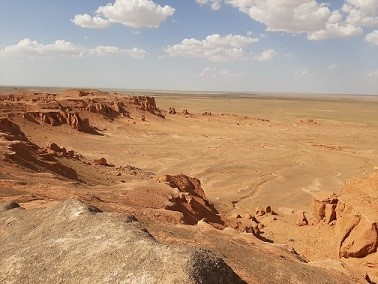
Continuing South through the centre of the South Gobi Desert we come to the Yolin Am Canyon in the Zuun Saikhan Mountain Range where ice can be seen all year round. The steep walls of the canyon make for an intriguing hike down the base of the canyon, horse riding is also available if you don’t fancy the walk!
The view from our Ger Camp this evening looks for all the World as if we’re looking out to sea such are the atmospheric conditions that exist in this part of the desert. Over dinner see if you can decide whether the tastefully clad restaurant is built on the level, while enjoying meeting our hosts this evening who go out of their way to make us feel at home.
Day 5 Yolin Am to Khongoryn Els ( approx. 220 Km )
The Khongoryn Els sand dunes also called Duut Mankhan are popularly known as the “Singing Dunes” due a thin surface of slate covering the sand grains causing the sand to resonate when the wind blows. The sound has been likened to an aircraft taking off and is thought to be magnified by hundreds of small avalanches that take place in windy conditions. These dunes are the largest in the Gobi. At up to 180km long, 12 km wide and a maximum height of 300m, they present a spectacular sight as we make our way into the Gobi Gurvan Saikhan National Park to experience this truly stunning landscape.
South and North of us now are rugged mountain ranges rising up to 8000ft providing a spectacular backdrop to the dunes and the table top terrain of the desert.
Our final destination is the unique Erdene Ger camp located in sight of the dunes with an amazing elevated open air viewing area where a pre dinner drink is a must and a post dinner visit to view the night sky should not be missed.

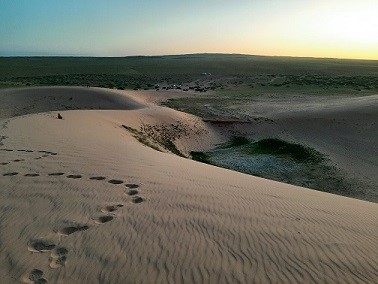
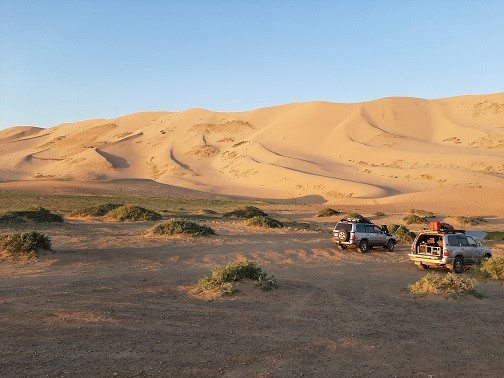
Day 6 Khonggoryn Els to Bayan Khongor ( 300Km )
A big day awaits us as we swing North from the southernmost part of the trip and head for the town of Bayankhongor (literally ‘rich darling’) which is the capital of the province. The city is at an elevation of 6100ft above sea level and has a population of 30,000.
Bayan Khongor province covers an area of 116, 000 square kilometres, approximately half the size of New Zealand. When you consider there are 22 provinces of similar size making up Mongolia, it’s easy to see why it’s one of the least populated in the world today.
After leaving the presence of the mighty dunes we open out into the vast wilderness of the Southern Gobi giving the convoy the chance to spread out and navigate their own track up to a kilometre apart, a unique feature of four wheel driving in Mongolia.
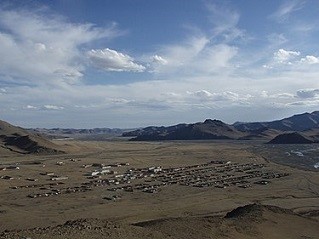
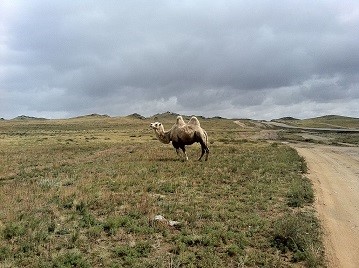
Our accommodation and meal this evening are at the Seoul Hotel and depending on arrival time, a chance to explore this slice of civilization in the middle of the Gobi Desert !
Day 7 Bayan Khongor to Altai ( 400 Km )
Heading due West on the well formed Route A0303 we have approximately 400km to cover as we pass along the valley skirted by mountain ranges and through the tiny settlements of Buutsagaan and Taygan. All the time getting closer to the spectacular Khsagt Khairkhan Mountain Range at 11800ft and the majestic Tayshiryn peak just South of Altai.
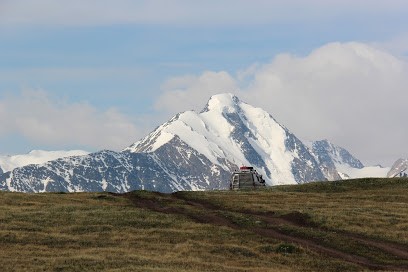
The town of Altai boasts two banks, a post office, two hotels, a bakery, a hospital, sports stadium, jet capable airport and a supermarket, so it’s a good place to stock up on lunch supplies! The climate here experiences long very dry and very cold Winters, recording lows of minus 40 degrees Celsius which is not so surprising when you consider it’s at an altitude of over 7200ft.
Two nights here will give us a chance to head out through the settlements of Tseel, Bayangol, Togrog and Sharga to get a closer look at the soaring peaks that abound in this part of Mongolia.
Our accommodation and meals for both nights are at the Entum Hotel which I’m told has plenty of good overnight parking!
Day 9 Altai to Khovd ( 450 Km )
Another big day mileage wise but the continuation of a good highway will make this run comfortable with lots of opportunities to photograph the Mongol Altayn Mountain Range which dominates this part of Southwest Mongolia.
Bordered on the Western side by the Buyant River and on it’s eastern flank by the Khar – Us Lake, Khovd has a population of 30,000 and due to it’s close vicinity to Khazakhstan and China the inhabitants belong to more than ten different ethnic groups and nationalities such as Uuld, Khalkh, Zachchin, Torguud, Uriankhai, Myangad, Durvud, Bayad, Kazak, Chantuu and Uzemchin .

Our accommodation and meals this evening are at the Steppe Hotel where we will be treated to a folk concert.
Day 10 Khovd to Ulgii ( 180 Km )
After the last few days an easy run into the land of Eagle Hunting where we will get a chance to experience this amazing custom. One of the four famous pursuits in Mongolia along with Horsemanship, Wrestling and Archery.
The centre of the predominantly Kazakh region of Mongolia, Kazakh is the primary language spoken in Ölgii. The city is home to at least 4 mosques. The city is known for its Kazakh embroidery and art, Kazakh music, and hunting with eagles. Each October, Ölgii hosts the annual Golden Eagle Festival which showcases the ancient Kazakh custom of eagle hunting.
Due to it’s extreme western location it is worth delving into Ölgii’s history which gives an insight to the whole of Mongolia as well:
It was an ethnic Kazakh village before the founding of the modern nation of Mongolia in 1911. Kazakhs have been coming to the Altai region of Mongolia for at least 200 years. Many came as Kazakhs faced pressure from the expanding Russian Empire. These numbers increased significantly after the 1917 Russian Revolution and the rise of Communism n china. It was the centre of Islam in Mongolia before religious purges in the 1930s in which the mosque was destroyed and the imam was executed. Mongolia initially tried to suppress Kazakh language and culture before creating Bayan-Olgii Aimag in 1939, with Ölgii as the seat of government.
Much of the centre of the city was built in the 1950s to 1980s. Ölgii developed less than the rest of Mongolia and was not connected by railroad or paved road due to its isolated location and lack of mineral resources. After the Mongolian democratic revolution in 1991 and the breakup of the Soviet Union, 25% of the population moved to newly-independent Kazakhstan. Though, many later returned and the population has largely recovered. In recent years construction has increased significantly resulting in many new apartments, shops, restaurants, and hotels (most have been built since 2005), mirroring a construction boom throughout Mongolia.
Like other post-communist cities, much of the industry closed down in the 1990s, although a large wool factory and many smaller animal related factories continue to process products from the 2 million animals in the Aimag.

Day 11 Olgii to Khyargas Nuur (Lake) ( 350 Km )
An early start for an all off road day to the Lake and a circumnavigation of Khargyas – Nuur including barging the vehicles across the inter lake channel at Khargyas Nuur where it’s all hands to the rope as we manpower the barge one vehicle at a time across this short channel.
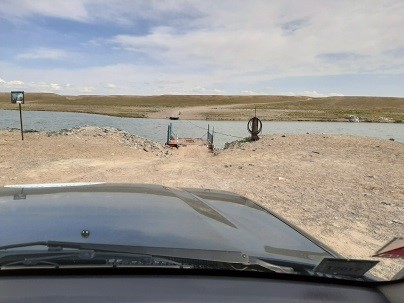
We are now in classic Mongolian grazing country that supports the nomadic herders synonymous with the Mongolian culture dating back to before the time of Genghis Khan and the prowess of Mongolian horsemanship.
We are back into our familiar Ger Camp accommodation this evening in a very scenic location right on the edge of Khargyas Nuur and a good excuse for a swim after a fairly long day on the Mongolian Steppe.
Day 12 Khargyas Nuur to Telten Nuur ( 330 Km )
A short off road run to the highway, then a nice cruise down the highway to take us within 40km of a remote Ger Camp south of Lake Telmen where we get to meet Dolgorjav Galsandorj and his lovely family .

Dolgorjav (Dogo for short), like a lot of rural Mongolians has had to be very resourceful and build this camp up with lots of hard graft and very little capital. The camp is well presented and the family make it a joy to stay at, one of my favourite Ger camps in Mongolia .
Day 13 Telten Nuur to Khorgo Lake ( White Lake ) ( 270 Km )
The wide open Steppe country is our companion today with a mixture of highway and some of the most picturesque steppe country on the trip so far. We skirt around the edge of Tsagaan Nuur through some interesting track conditions, some rocky sections and some muddy sections on the lake edge as we approach the last section of track to Khorgo Lake.

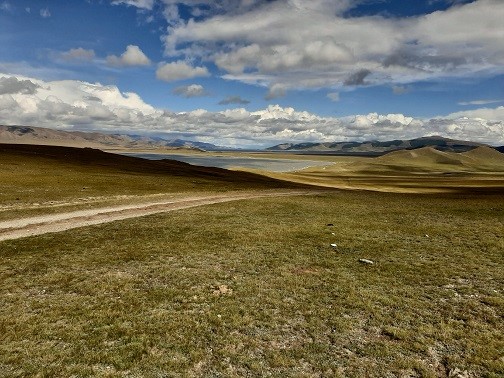
Day 14 Khorgo Lake, Volcano hike, Horse riding
A welcome respite after 12 days on the road, we get to stay a second night at this Ger camp where I can highly recommend the laundry service.
A side trip to climb the extinct volcano and a walk around the edge of the crater is well worth the effort. With great views of the surrounding landscape dominated by the lava flows from the eruption that occurred 1000’s of years ago and still evidenced by the type of plants that have adapted to the volcanic rock and soils.
Horse riding is available on request, your chance to experience the famous Mongolian horses that date back to the days of Genghis Khan.
The main restaurant building at this camp has the dining in a great location on the second story overlooking the lake and surrounds and is a very pleasant spot to be having a second night.
Day 15 Khorgo Lake to Hot Springs via Tetserleg and Australian Café ( 170 Km )
Back over the hill as we say goodbye to Khorgo Lake and the volcano. The track today takes us off road initially out onto the main Northern Highway as we continue East to the town of Tetserleg .
Here we’ll explore the local market which often has some local craftware worth purchasing for a trip momento and then on to the café for lunch owned by an Australian who succumbed to the wiles of a local lady and has been here ever since!
After lunch we head off road across some of Mongolia’s richest grazing lands. In this area there are regular encounters with the traditional mixed herds of sheep and goats, herders’ Ger tents and their horses. The herds are mustered out every morning to a new grazing area and brought back each evening for security from marauding wild animals such as wolves, wild boar and foxes.
Our destination this afternoon is the Hot Springs Ger camp with thermal swimming pools and a good restaurant.

Day 16 Hot Springs to Kharkhorin the Ancient Mongolian Capital ( 120 Km )
An easy run across country and then back onto the main North Highway brings us to the ancient Capital of Kharkhorin where we get to spend two nights allowing a day to explore the town, the temple, and visit the monument built overlooking the town to showcase the mighty Mongolian Empire created by the armies of Genghis Khan.
It is from the monument viewpoint that you can get an idea of just how vast the Mongolian war machine was with illustrations of the area adjacent which the army occupied when not out campaigning.
We also get a chance to watch a local Archer in action and try our hand at Archery. This will take place just across from our Ger camp which was built by Dagvadorj Asashoryu, who had a very successful career as a champion Sumo Wrestler in Japan and has since invested his winnings into an impressive portfolio of companies based around Ulaanbaatar and Kharkhorin.
If you haven’t experienced traditional Mongolian singing this evenings entertainment at this particularly comfortable Ger camp won’t fail to impress , along with some great accompaniment by the group playing all traditional instruments it’s always a great night.
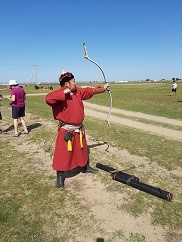
Day 18 Kharkhorin to Ulaanbaatar, Hustai National Park ( 300 Km )
Our last day on the road will see us travel through the Hustai National Park, home of the project to reintroduce the indigenous Takhi or Przewalski’s Horse, which up to 1993 was in danger of becoming extinct. It is believed that the herders horses of today are all descended from this famous wild horse which gave the Mongol armies so much mobility and dominance over such a huge empire.
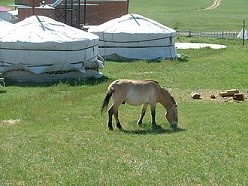
We will also visit the Genghis Khan Equestrian Statue, a 131-foot (40 m) tall statue of Genghis Khan on horseback, on the bank of the Tuul River at Tsonjin Boldog, 54 km east of Ulaanbaatar, where according to legend, he found a golden whip. The statue is symbolically pointed east towards his birthplace. It is on top of the Genghis Khan Statue Complex, a visitor centre, itself 10 metres (33 ft) tall, with 36 columns representing the 36 Khans from Genghis to Ligdan Khan. It was designed by sculptor D. Erdenebileg and architect J. Enkhjargal. Eerected in 2008, it is constructed of stainless steel.
We will walk to the head of the horse through its chest and neck, for a very impressive panoramic view. The main statue area is surrounded by 200 ger, designed and arranged like the pattern of the horse brand marks that were used by the 13th century Mongol tribes. The cost of the complex is reported to be US$4.1 million, spent by The Genco Tour Bureau, a Mongolian company.
Back to our Hotel at Bayangol and a chance for a well earned drink at the very pleasant rooftop bar overlooking the city with dinner this evening at the hotel restaurant.
Day 19 Ulaanbaatar half day city tour, Farewell Dinner
This half day tour in Ulaanbaatar gives you a chance to visit some good craft shops, cashmere shops that Mongolia is famous for and see some of the interesting sights this bustling city has to offer.
The final Team Dinner this evening is always a brilliant night with new found friends and a chance to reflect on the amazing places we’ve experienced and people we’ve met along the path of a truly memorable adventure!
Note : Transfers from your Hotel to the airport are included in your trip fee. You just need to let us know well in advance incoming and outgoing flight details and if you decide to arrive earlier or depart a bit later we can arrange accommodation to suit.
___________________________________________________________________________
Overview of some of Mongolia’s Wildlife
Mongolia has a number of large mammals, including gray wolves and Siberian ibex (Capra sibirica), as well as more endangered species such as the wild Bactrian camel (Camelus ferus), the snow leopard (Uncia uncia), the Gobi bear, (rarest and unique to the desert region), the takhi (both wild and domestic types of horses) and the Asiatic wild ass (the largest numbers in the world are found in the Gobi desert).[1]
The saiga antelope, once a common species, has been reduced by pressures including hunting, livestock grazing, and high Chinese medicinal value, with the Mongolian subspecies reaching a critically endangered level, with fewer than 5,000 individuals left in the wild.[4] The wild horse, in particular, had almost become extinct (not seen for more than three decades) and was therefore reintroduced from captive sources. Other species of mammals reported include: argali (Ovis ammon) (in the rocky mountains of the Gobi desert), common wolf, Mongolian saiga (Saiga tatarica mongolica), musk deer (Moschus moschiferus), Pallas’s cat (Felis manul) or manul, black tailed gazelle (Gazelle subgutturosa), stone martin (Martes foina), and wild cats in the Altai ecoregion; wild boar (Sus scrofa nigipes), red deer (Cervus elaphus), roe deer in the forest areas and muskrat, red fox, steppe fox, and sable in the forest and steppe margin areas.
Under the WWF-Mongolia conservation programme (a four-year project), snow leopards, Altai argali sheep and saiga antelope and gazelle of eastern Mongolia are receiving special attention.[ The Zoological Society of London has taken interest to conserve Bactrian camel, long-eared jerboa (Euchoreutes naso), Mongolian gerbil (“meriones unguiculatus”) and saiga antelope.[21]
Birds[edit]
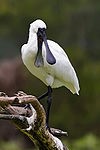

Above : A Spoonbill; Below : a great white Egret
The bird species in Mongolia include several that are very large; six species of cranes present account for half the numbers in the world. There are 22 endangered species of birds including hawks, falcons, buzzards, cranes and owls. Though cranes are not hunted for superstitious reasons, they are still threatened due to habitat degradation and only 5000 breeding pairs are reported, mostly in Dornod’s Mongol Duguur Strictly Protected Area. In eastern Mongolia, a critically endangered species of crane is the white naped crane (Tsen togoru). Overall there are 469 species of birds, including domesticated species linked to wild ancestral species. Of these, 330 species are migratory and 119 are seen in Mongolia throughout the year. Species identified include: golden eagle (Aquila chrysaetos), lammergeyer (Gypaetus barbatus), spoonbills (Platalea leucorodia), Dalmatian pelican (Pelecanus crispus), great white egrets (Egretta alba), whooper swans (Cygnus cygnus), great black-headed gulls (Larus ichthyatus), black storks (Ciconia nigra), swan goose (Anser cygnoides) and snowcock (Tetraogallus altaicus) or Altain ular.
Aquatic life[edit]

The rivers and lakes of Mongolia are reported to have 76 species of fish, including trout, grayling (khadran; the Arctic grayling and the Mongolian grayling can be widely found in Mongolian rivers, roach, lenok (zebge), Siberian sturgeon (khilem), pike (tsurkhai), perch (algana), Altai osman (endemic to the rivers of Mongolia[22]) and the taimen (a huge Siberian salmon relative, growing up to 1.5 m in length and 50 kg in weight.
Threats and conservation]
In a country where Russia was supporting the economy with grants until it became independent in 1990, the situation drastically changed after independence. The country’s revenue resources then depended more from the wildlife resources and its landscape, which were subject to serious exploitation necessitating a policy change towards ecotourism to generate revenue to preserve the remaining biodiversity of the country. Other than official action to raise resources of the state, other major threats faced are illegal hunting (for musk deer, elk, boars, squirrels and marmot for illegal trade), grazing of pasture livestock and related needs of water resources (due to large increase in livestock population since 1990), climate change, fires in steppe and forests (resulting in death of many animal species) and severe weather conditions of winter and drought condition.


